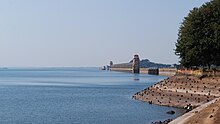Tungabhadra Dam
| Tungabhadra Dam ತುಂಗಭದ್ರಾ ಜಲಾಶಯ |
|
|---|---|
 |
|
| Location | Hospet, Ballari district, Karnataka, India |
| Construction began | 1949 |
| Opening date | 1953 |
| Owner(s) | Karnataka state |
| Operator(s) | Tungabhadra Board |
| Dam and spillways | |
| Type of dam | Composite, Spillway length (701 m) |
| Impounds | Tungabhadra River |
| Height | 49.50 m (162 ft) from the deepest foundation. |
| Length | 2,449 m (8,035 ft) |
| Spillway capacity | 650,000 cusecs |
| Reservoir | |
| Creates | Tungabhadra Reservoir |
| Total capacity | 101 tmcft at FRL 498 m msl |
| Active capacity | 98.7 tmcft (at 498 m msl) |
| Inactive capacity | 2.3 tmcft (below 477.01 m msl) |
| Catchment area | 28,180 km2 (10,880 sq mi) |
| Surface area | 350 km2 (140 sq mi) |
| Power station | |
| Operator(s) | Karnataka Govt |
| Turbines | Near toe of the dam and canal drops |
| Installed capacity | 127MW |
The Tungabhadra Dam is constructed across the Tungabhadra River, a tributary of the Krishna River. The dam is near the town of Hospet in Karnataka. It is a multipurpose dam serving irrigation, electricity generation, flood control, etc. This is a joint project of erstwhile Hyderabad state and erstwhile Madras Presidency when the construction was started; later it became a joint project of Karnataka and Andhra Pradesh after its completion in 1953. The main architect of the dam was Dr Thirumala Iyengar, an engineer from Madras.
The dam creates the biggest reservoir on the Tungabhadra River with 101 tmcft of gross storage capacity at full reservoir level (FRL) 498 m MSL, and a water spread area of 378 square kilometres. The dam is 49.39 meters high above its deepest foundation. The left canals emanating from the reservoir supplies water for irrigation entirely in Karnataka state. Two right bank canals are constructed — one at low level and the other at high level serving irrigation in Karnataka and Rayalaseema region of Andhra Pradesh. Hydropower units are installed on canal drops. The reservoir water is used to supply water to downstream barrages Rajolibanda and Sunkesula located on the Tungabhadra River. The identified water use from the project is 220 tmcft by the Krishna Water Disputes Tribunal. Karnataka and Andhra Pradesh got 151 tmcft and 79 tmcft water use entitlement respectively.
On the right side of the dam, tall Sanduru hill ranges extending up to 800 m MSL are close to the periphery of the Tungabhadra reservoir. These hill ranges form the Sanduru valley located above 600 m MSL. This reservoir is an ideal place to install pumped storage hydropower plants and lift irrigation projects. A moderate high level storage reservoir of capacity 20 tmcft at FRL 620 m MSL, can be constructed by damming the Sanduru valley. This reservoir will serve as upper pond and existing Tungabhadra reservoir as tail pond for installing pumped-storage hydroelectricity units. The water pumped during the monsoon months into the upper pond can be diverted by gravity to irrigate an extensive area in the uplands up to 600 m MSL in Rayalaseema and Karnataka. This water can be pumped further to meet the drinking water requirements of Bengaluru city.
...
Wikipedia
